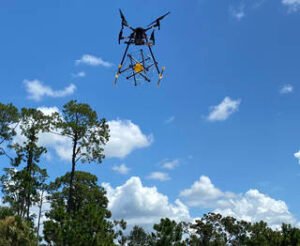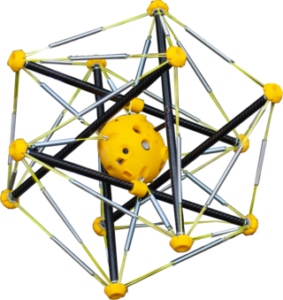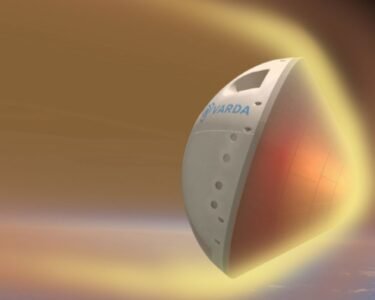Dr. Alice Agogino was working on spherical robots that could one day be dropped onto Mars or the Moon to collect data and conduct the study when she discovered her NASA-funded technology could also be used on Earth.
What kind of data can the robots collect on Mars or the Moon?
After reading a study on the dangers and death tolls of disaster response, Agogino envisioned her robots, outfitted with the appropriate sensors, gathering data at the scenes of fires, wrecks, and other disasters to assist first responders in assessing dangers such as hazardous gas leaks and planning their approach.

Credits: Southern Manatee Fire and Rescue
Dr. Alice Agogino:
“We thought, wow, if we can do this on the Moon, we can do it on Earth and save some lives,” said Agogino, who was then the director of the University of California, Berkeley’s Berkeley Emergent Space Tensegrities Lab.
She went on to cofound Squishy Robotics Inc. in Berkeley, California. The business designs and manufactures impact-resistant, customizable robots for public safety, military, and industrial applications.
What is the concept behind the construction of Squishy Robotics Inc.’s robots?
Agogino’s robots have the appearance of ball-shaped skeletons made of rods and elastic cables. She refers to the construction as “a tension network” because when a robot is dropped, the impact is dispersed over the network, dissipating the force, according to the tensegrity principle. Tensegrity, short for tensile integrity, was coined by architect R. Buckminster Fuller in the 1960s, who popularized geodesic domes, which are also tensegrity constructions.
The ability of these structures to resist the impact of a lengthy drop is very intriguing to NASA, as is their ability to collapse into a small package during transit.
How much Agogino and her UC Berkeley group was awarded and why?
Agogino and her UC Berkeley group were awarded Early Stage Innovations (ESI) money in 2014 to study tensegrity robot mobility utilizing gas thrusters. The multi-year, $500,000 ESI proof-of-concept grants aim to speed the development of novel space technologies with great promise. The funds are provided by the Space Technology Research Grants program, which assists academic scholars working on space-related science and technology.
What is the focus of Agogino and her colleagues’ research?
Agogino and her colleagues were developing probes that could drop from planetary orbit or larger spacecraft, survive the plunge while carrying sensitive sensors, and then roll and hop through rugged terrain to perform missions and study distant worlds.

Credits: Squishy Robotics Inc.
Terry Fong:
“Think about the Mars Curiosity and Perseverance rovers,” said Terry Fong, chief roboticist in NASA’s Ames Research Center in Silicon Valley, California.
What are the current updates of the rover on the moon?
The rovers had to be delicately lowered to Mars’ surface using the sophisticated Sky Crane system, according to Fong, NASA’s technical representative for Agogino’s grant.
“With tensegrity robots, the robot itself is the landing device,” Fong explains. “It could survive a fall from very high up and keep going.”
The tensegrity devices can be folded flat for transport; in fact, Agogino distributes robots to customers in this manner. The instruments and sensors are suspended in the center when they unfurl, protecting them from the impact of a fall.
“So, you save on throwaway mass,” Fong explained. “It’s expensive and difficult to launch mass into space, so you want more of it to be used beyond landing, on the surface with scientific instrumentation and other payloads.”
How is NASA using tensegrity robots in Earth science research?
Tensegrity robots, whether on Earth or on other planets, make it easier to position delicate instruments in difficult-to-reach regions. That is, after all, the underlying premise of Squishy Robotics. NASA has investigated Earth science uses for tensegrity robots, which may monitor a glacier that is poised to break off into the ocean, for example.
“That’s the kind of place you wouldn’t want to send a person to because it’s extremely dangerous,” Fong explained.
“The entire surface may collapse.” A super instrument positioning system would be a structure that could withstand a drop while remaining mobile.”
What is customer discovery and how did Agogino and her team use it?
In a process known as customer discovery, Agogino, and her team interviewed 300 first responders. Squishy Robotics now incorporates miniature chemical gas sensors onto tensegrity robots that may be dropped by aircraft to take readings in an area before firefighters arrive. The company now only provides stationary robots, but Agogino and her team are working on mobile ones.
The data collected by these robots can help firemen decide whether to wear hazardous material gear, which can add up to an hour of prep time – a delay that is only worthwhile if it is absolutely essential.
Which agencies have Squishy Robotics collaborated with?
Squishy Robotics has collaborated with some of the country’s largest fire agencies, including Southern Manatee Fire and Rescue in Florida, Tulsa Fire Department in Oklahoma, and San Jose Fire Department in California. In addition, the company has reseller partnerships with a number of wholesalers.
What are the potential applications of Agogino’s tensegrity robots?
- Defusing of bombs:
Agogino’s tensegrity robots could also aid in the defusing of bombs and the monitoring of gas and electric lines.
- Wildfire prevention:
Another emerging field for Squishy Robotics is wildfire prevention. Tensegrity robots might be used to monitor high-risk regions, assist authorities in responding to reports, and ensure that lesser fires are completely doused.
“The early detection of wildfires is critical,” Agogino says, “because so many of the wildfires that have become raging firestorms could have been prevented if they had been caught early.”
NASA’s Fong expressed delight that Agogino was able to commercialize the tensegrity robot technology. “We believe these robots could serve unique purposes for space,” he said. “She obviously saw a way to also have a major impact on Earth.”
Additional Information:
Agogino is currently emeritus, having retired from Berkeley in December, allowing her to devote more time to Squishy Robotics. NASA has a long history of technology transfer to the private sector. The agency’s Spinoff publication highlights NASA innovations that have evolved into commercial products and services, illustrating the broader advantages of America’s investment in space. The spinoff is a magazine of NASA’s Space Technology Mission Directorate’s (STMD) Technology Transfer program.





